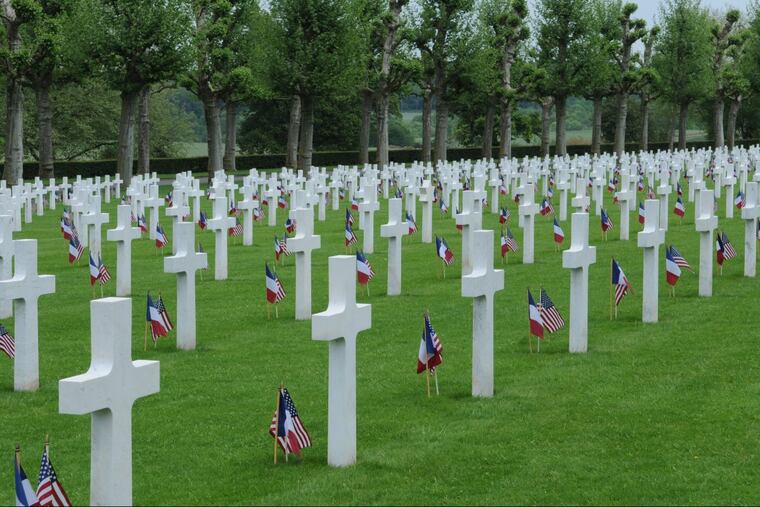In a French cemetery, honoring sacrifices made for freedom
The blinding-white crosses were a sober reminder that this forgotten war had laid the foundation for our country's emergence as a global leader that was willing to sacrifice its youth to liberate war-ravaged countries that shared our values.

The temperature was 95 degrees, and there was no shade, just the heartbreaking blur of nearly 15,000 headstones in the Meuse-Argonne American Cemetery and Memorial in northeastern France. On Memorial Day, we wove through the endless white rows of World War I dead on our way to the first of two graves that held special meaning for me and the seven other visitors from Bucknell University.
The blinding-white crosses, flanked by French and American flags, were a sober reminder that this forgotten war had laid the foundation for our country's emergence as a global leader and superpower that was willing to sacrifice its youth to liberate war-ravaged countries that shared our values.
In four years, the war took the lives of 1.1 million British, 1.4 million French, and 2 million German soldiers — sometimes gutted, sometimes gassed, often blown to bits or shredded by machine-gun fire as they charged up a hill in a doomed attempt to move the enemy line back a few meters.
Pacing the rows, we spied the marker for Second Lt. Baker Fairchild Spyker, a native of Lewisburg, home of Bucknell, and the first World War I casualty we visited during a 10-day tour of memorials and other sites in France and Flanders pertinent to Bucknellians who had served in the war. Spyker was killed Oct. 13, 1918, less than a month before the war's end — one of 116,000 Americans who gave their lives to support our European allies and end one of history's bloodiest wars.
We saw the results of this folly at the Menin Gate in Ypres, Belgium, a city that had been leveled in the war and then rebuilt to replicate its historic character. The marble walls stretched four stories high into the cloudy sky, interminably etched with the names of 55,000 English and Commonwealth soldiers whose bodies had never been found. Many had perished in the first-ever use of poison gas. At the monument's base we read a grateful, handwritten note recently left by the granddaughter and great-granddaughter of a British man killed in 1916.
We wiped away tears as we peered at the mingled bones of an estimated 130,000 German and French soldiers in the ossuary at Verdun. In death, these foes were one.
As we tramped through the Argonne Forest, with its mystical light and eerie stillness, we saw that in 100 years an environment could turn from terrifying to tranquil, but still harbor deadly surprises. Going off trail would risk encountering the many live artillery shells nearly hidden in tall grass.
We witnessed the grandeur of gratitude as we climbed the steps to touch the smooth, soaring, formal Greek columns of the Pennsylvania Memorial at Varennes-en-Argonne — the largest tribute by a state to its World War I veterans. While this monument majestically honored those Pennsylvanians who fought in the Meuse-Argonne offensive, the bridge over the Vesle River at Fismes made a less-imposing and not-as-well-preserved statement. Built in 1928 by Pennsylvania to honor the soldiers of the 28th Division, who turned back the Germans there in July 1918, the bridge is crowned with two tunic-draped women on tall, discolored columns. Busts of doughboys, pieces of their helmets broken off, the Pennsylvania coat of arms, and the year, 1918, in big gold numbers, embellish the column bases.
On Memorial Day, we left Baker Spyker's grave with a blue-and-orange Bucknell banner and a prayer of thanks, then moved on to Second Lt. Wilson Chalmers Acheson of Pittsburgh, who fell a day before Spyker. The parents in our group imagined what it would be like to sacrifice a son to such wanton slaughter. Bucknell senior A.J. Paolella, who had turned 22 a few days earlier, saw himself had he been born 100 years earlier.
Paolella, whose French great-grandfather lost a leg in the war, cut to the quick of what many of us felt: "I couldn't be more proud of what we've done. Most Americans tend to forget about the importance of World War I and the Americans who selflessly did this for the rights of people around the world. They are here so we don't have to experience this again."
Sherri Kimmel of Mechanicsburg, Pa., is the editor of Bucknell Magazine. slk023@bucknell.edu